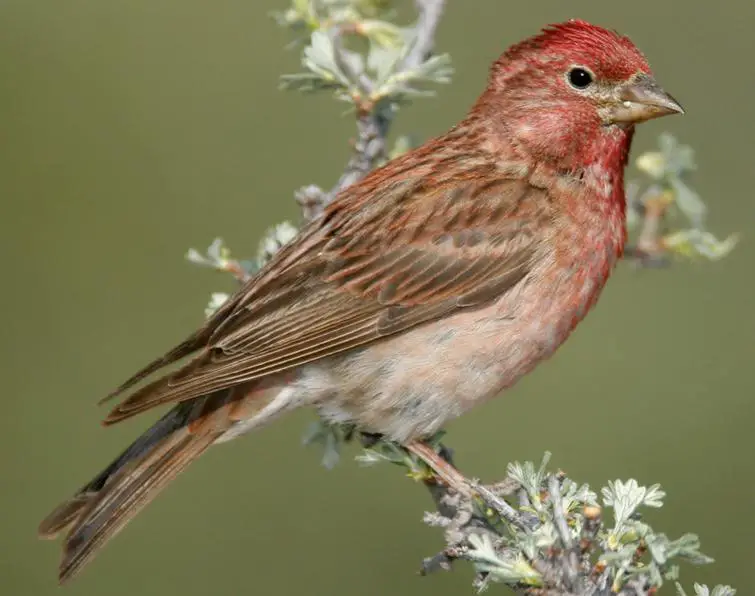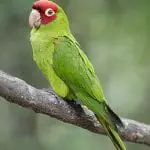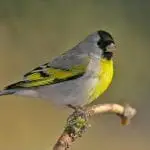Scientific Facts
| Common Name | Cassin’s Finch |
| Scientific Name | Haemorhous cassinii |
| Lifespan | 7 Years |
| Size | 6.3 inches |
| Mass | 0.8 – 1.2 oz |
| Habitat | Forests |
| Range | North America |
Information & Physical Appearance

Scientifically referred to as Haemorhous cassinii, the Cassin’s finch belongs to the order Passeriformes, the family Fringillidae (the finch family), the subfamily Carduelinae.
The body coloration of adult male Cassin’s finches is overall rosy pink. The most saturated red nuances are located on the crown.
The body coloration of female adult Cassin’s finches is overall brown and white. It is on the females’ underparts and chest zone where crisp, well-defined dark streaks can be noticed. The coloration of immature Cassin’s finches resembles the appearance of adult females.In both sexes, the undertail coverts are streaked, and in most cases, a thin white-colored circle around the eye (aka eyering) is also present.
Adult Cassin’s finches weigh between 0.8 and up to 1.2 oz. In size, these birds typically reach up to 6.3 inches, being larger than Pine Siskins, and about the same size as House Finches, although a bit heftier. Their wingspan measures at 9.8 and up to 10.6 inches.
Interestingly, this bird species’ wings are fairly long, and so when perched, the very tips of the wings are to project significantly farther down the length of the tail, as compared with other finches.
These small songbirds are “equipped” with short-medium tails that are visibly notched.
The closest relative of the Cassin’s finch is Haemorhous purpureus, the Purple finch. Being part of the same genus (genus Haemorhous), the Cassin’s and the Purple finch have much in common when it comes to voice, plumage, morphology, higher elevations preference during the breeding season, as well as their restricted western distribution.Even though sharing certain common traits with the Purple finch, the Cassin’s Finch is often mistaken for a House finch. The reason for this confusion is the similar coloration of these bird species. However, if one is to look closely and carefully enough, there are certain differences that are easy to recognize.
As compared with the adult male House finch, the adult male Cassin’s finch is much pinker in color. Also, the bellies and breasts of Cassin’s finches are not streaked, unlike the bellies and breast of the House finches. Additionally, Cassin’s finch males can raise their crown feathers, forming the shape of a small crest, while this is not the case with House finches.
With adult female Cassin’s finches, the streaking is significantly better defined than with adult female House finches, even though both are brown-streaked overall.
Both male and female Cassin’s finches are larger in size than house finches. While House finches possess curved upper bills, Cassin’s finches’ bills are conical-shaped.
Ultimately, the house finch, the purple finch, and the Cassin’s finch used to be formerly placed in the genus Carpodacus, altogether with Eurasia’s rosefinches. However, researchers managed to find out that neither of the three North American finches is closely related to the Old World rosefinch radiation.
Because of this, most taxonomic authorities re-classified the purple finch, the Cassin’s finch, and the house finch into the genus Haemorhous.
Lifespan
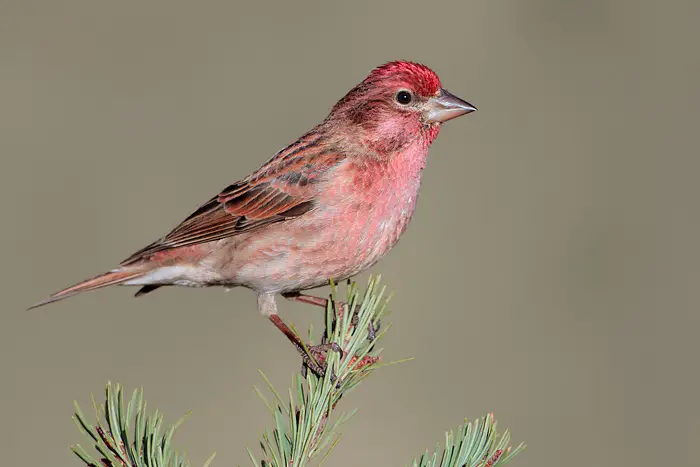
According to the World Life Expectancy database, the average lifespan of the Cassin’s finch is 7 years. The generation length is set at 4 years. In comparison, the expected longevity of the purple finch is estimated at between 2 – 11 years of age.
Ecosystem & Habitat
Cassin’s Finches occupy up to about 10 000 feet elevation. These birds live high up in the mountains, thriving in the evergreen forests.
During the cold winter season, they are to move to lower elevations in the forest throughout much of the same range. When it comes to breeding, Cassin’s Finches are to choose the western interior of North America’s conifer belts, spanning across central British Columbia to the northern parts of Arizona and New Mexico. Breeding typically takes place at an elevation of between 3 000 – 10 000 feet.Additionally, some Cassin’s Finches are known to breed in open sagebrush shrubland where scattered western junipers are present.
Typically, Cassin’s finches inhabit forests that are greatly dominated by mature ponderosa pine and lodgepole pine. However, it is also possible to find these birds in forests consisting of Douglas-fir, limber pine, subalpine fir, Jeffrey pine, red fir, bristlecone pine, grand fir, pinyon pine, Engelmann spruce, and quaking aspen.
Food & Diet
Cassin’s finches are foragers. Even though they usually forage in trees, it is not uncommon to forage in ground vegetation, too.
The diet of these birds consists mainly of seeds, berries, buds, as well as a smaller, yet substantial amount of insects.
Some of the berries these feathery creatures eat include mulberries, cotoneaster berries, and firethorn berries. They also eat other kinds of fruit, such as grapes and apples. Nonetheless, cottonwood buds and green manzanita buds are gladly taken.
Ponderosa pine seeds are a major food source. The seeds are extracted from the cones by being pulled out. In addition to that, fallen ponderosa pine cones seeds are collected from the ground, too.
In the springtime, the major food source is quaking aspen buds, making up for 94% of the diet.
In the summer season, Cassin’s finches are to eat a good amount of insects, including the larvae of Douglas-fir tussock moths. Butterflies and other moths are more than welcome, too.
When the summer is soon to come to an end, and up to early fall, Cassin’s finches need to satisfy their salt cravings. They do so by gathering with crossbills, as well as other mountain birds, into foraging groups. The foraging groups then commonly visit mineral deposits together.
In fact, Cassin’s finches do often feed in flocks, not only as far as satisfying their seasonal salt cravings is concerned.
Behavior
Following their very first molt, known as the Prebasic molt, males are still wearing the female-like grab in darb brownish in their first breeding season. At this point, the young males’ songs closely resemble the songs of older males. Thus, because of the young males sharing a similar appearance with females, the false impression that both sexes sing equally complexly is given.
It is often the case that Cassin’s Finches are to produce an astonishing set of imitations. They can imitate perfectly the sounds of other birds, and they do so near the end of their traditionally thrilling songs as if a talented virtuoso is to insert a solo passage into musical work.
Throughout the years, due to Cassin’s finches’ master skills at imitating sounds, a number of field workers have got to search in vain for particular bird species, believing that they have actually heard the bird, yet were merely fooled by the excellent mimics of Haemorhous cassinii. It is in late summer and early fall when Cassin’s finches are to get together in groups. It is during this time of the year when they can be most commonly spotted foraging alongside different mountain birds, such as crossbills (Loxia). These small flocks are to collectively visit mineral deposits were satisfying their salt cravings take place.
Other members of the finch family do also require a certain amount of salt in their diets, too.
When the winter season begins, Cassin’s finches are to drift southward. Furthermore, they move to lower elevations where the climate is much more tolerable. Up until it is time for these finches to depart for the high country, which occurs early in spring, they may become regular visitors to bird feeders within their range.
Even though Cassin’s finches visiting bird feeder from winter through early spring may happen on a regular basis, these birds’ occurrence at just about any given locality greatly varies from one year to another. Like other finches, Cassin’s finch local availability is related to irruptive years.
It is the Cassin’s finches’ unpredictable migration behavior to suggest these feathery creatures as irruptive species, which is also the case with Red Crossbills, Pine Siskins, Red-breasted Nuthatches, and Evening Grosbeaks.
Irruptive species are known to move together in large flocks, traveling to new areas while searching for food that is lacking in their usual winter range.
Ultimately, Cassin’s finches are suggested to migrate both altitudinally, as well as latitudinally.
Up-to-date, astonishingly little in-depth work has been done on the Cassin’s finch, despite this bird’s occurrence being so prevalent.On the bright side, in the lack of detailed work, there are many possibilities for new, exciting discoveries in the foreseeable future. When feeding, Cassin’s Finches will mix with siskins and crossbills, among other montane finches, so one of the best ways to spot their presence in the flock is by listening for their “tulip,” rising, giddy-up call notes, and for their rich songs that often include certain parts of the songs of other birds.
As a rule of thumb, the Cassin’s finch rich musical warble song is noticeably softer in tone, as compared with the Purple finch’s song.
The flight patterns of the Cassin’s Finch is described as undulating. While flying, these birds will rise when they flap. When they glide, they are to dip.
As soon as the female Cassin’s finch begins to look for a suitable nest site, the male is to accompany her, chasing away any other males from the selected area.
When the Cassin’s finch is to make a threat, the bird is to start by closing its bill. Next, the closed bill is to be pointed towards the opponent, while the body is in a horizontal position, and the neck is extended.
When the female is to make a threat, she may choose to ruffle the feathers located on the breast, back, and forehead area. This particular behavior is used as an indication that the female is nota young male since, during their first year of life, young males look quite similar to adult females.
Furthermore, whenever threatened, these finches are known to freeze in a crouch. At this very moment, they are to make very soft alarm calls while simultaneously moving none other parts of their bodies but their throats.
Even though Cassin’s Finches do form one-on-one pairs to guard the nest, it is suggested that they do most probably mate outside the pair bond, too.Whether Cassin’s finches are strictly monogamous, forming a strong bond that lasts for a lifetime with their mate, remains unknown, since experts have not yet managed to find out reliable evidence on these birds reuniting with one and the same mate year after year.
Reproduction
When it is time to choose a suitable nest site, both the male and the female Cassin’s finches in the breeding pair are to get involved in the process. However, the male only accompanies the female, and it is the female to have the final stance on choosing the most appropriate nest site.
Usually, the nest is to be positioned at least 15 feet, or more, from the ground, on either the side of a branch that is located away from the tree trunk or very near to the very top of a conifer tree. Sometimes, females are known to choose nest sites that happen to be only a few feet apart. In such instances, males may or may nottolerate such close nest spacing. If one pair is well-over the egg-laying stage by the same time another pair is to move in, then the males will tolerate the close spacing.
The construction of the nest is a responsibility of the female Cassin’s finch. The nest is made within only a few days. Overall, it is rather frail and loose.
The nest building process begins with the female creating a foundation consisting of rootlets, fine twigs, coarse weed stems, and, more often than not, lichens.
The inner cup of the nest may sometimes exceed 2 inches across x 1 inch deep. It is lined with plant fibers, animal hair, grass stems, fine rootlets, and shreds of bark. Sometimes, shreds of rope are also utilized.
The clutch size varies from 3 and up to 6 eggs. Cassin’s finches may raise only a single brood per year, or they may also raise 2 broods.
The Cassin’s finch egg’s length is estimated at between 0.7 and up to 0.9 inches. In width, a single egg typically measures from 0.5 inches to 0.6 inches.
The eggs are light greenish blue in color. Additionally, they are speckled with purplish, black, and brown.
The incubation period lasts for about 12 days. Upon hatching, the young are covered with sooty gray down.
Health Risks, Survival Threats & Conservation
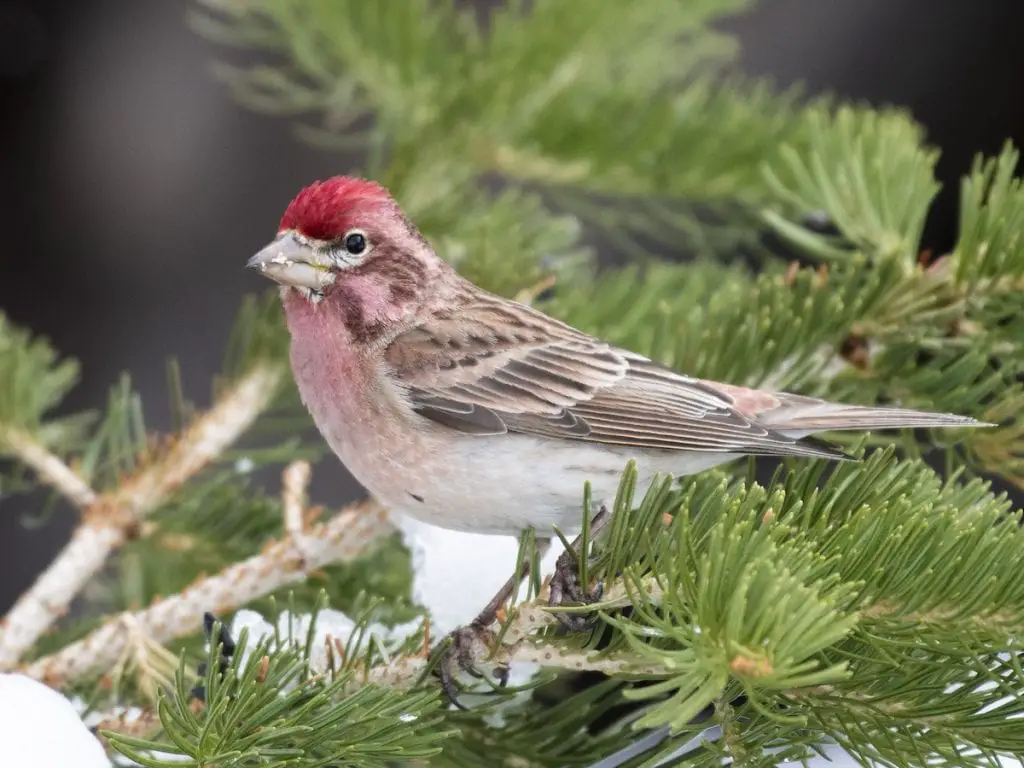
Cassin’s finches may be infected with various strains of avian poxvirus. In such cases, the skin lesions are typically easy to observe at a mere glance.
Just like the case with other passerine birds, Cassin’s finches may be infected with salmonellosis.
Cassin’s finches may also fall victim to exposure to AFs (aka aflatoxins), as well as OA (aka ochratoxin). This can lead to a wide range of adverse effects, such as chronic subclinical impairment of immune function, reproduction, and growth, to acute toxicosis. AFs and OA are produced by filamentous fungi in the genera Penicilliumand Aspergillus.AFs and OA, being secondary metabolites, have been proven to be present in peanuts, among other foodstuffs, that is widely used in foods sold for feeding garden birds.
Finch trichomonosis caused by the protozoan parasite Trichomonas gallinae may also occur.
It is extremely important to note the crucial impact of providing supplementary food, whether this is done intentionally and unintentionally, since food provision has shaped and keeps shaping food webs and ecosystems, and the case with the Cassin’s finch is not any different.
In particular, the provision of food at garden bird feeders has a strong potential in influencing bird populations over a larger area.
The way birds can be influenced by food provision is not only directly and positively, thanks to the nutrients and energy provided, but also indirectly. Food provision is intricately related to the alternation of pathogen dynamics, or in other words, the way a particular disease can be transmitted to a wider population because of birds using bird feeders being attracted from a significantly wider area, gladly arriving when natural foods become scarce.
In summary, garden feeding stations may facilitate disease transmission, thus, possibly affecting populations adversely, especially since contrary to the well-studied negative effects of pesticides and heavy metals like the role mycotoxin contaminants found in food supplies play is still being widely ignored.
Mycotoxin contamination occurrence is much is higher in wet, warm conditions. Additionally, wet and warm conditions are becoming more likely to occur because of climate change. Pathogens’ ability to persist in a particular environment is still very poorly known, however, based on existing experiments, T.gallinae can survive in the seed with organic material for less than 48 hours vs. less than 24 hours in a moist seed.
Not the least, the food provision method, for instance, providing food using a hanging feeder vs. a bird table, does also influence the likelihood of exposure to pathogens.
Horizontal feeding surfaces have been found to increase the likelihood of the transmission of T.gallinae, because of birds getting exposed to regurgitated food and/or saliva from infected birds.
Hanging feeders may increase the likelihood of both direct and indirect contact rates alike through mesh or perches, thus, possibly facilitating the transmission of poxvirus.
On the other hand, tube style feeders have been found to increase the risk of house finch conjunctivitis, as this particular disease is transmitted by both direct and indirect contact.
Last but not least, there is an increased risk for interspecific mixing when it comes to birds sharing feeders, therefore, elevating the risks of one species transmitting pathogens to another species. Ever since 2004, the Cassin’s Finch has been categorized on the IUCN Red List of Threatened Species asNear Threatened. Also, the Cassin’s finch is part of the 2016 State of North America Birds’ Watch List. The State of North America Birds’ Watch List includes bird species that face the highest risk of becoming extinct, and that are being provided with very little to none conservation actions to help reduce survival threats and reverse population declines.
Cassin’s finches’ population declines are most noteworthy in the Northeast. According to data by Partners in Flight, it is estimated that the global breeding population of these finches consists of 2.9 million birds. 95% of these birds are to spend at least some part of the year in the United States. Meanwhile, 5% is to breed in Canada, with 22% estimated to winter in Mexico.
The Cassin’s finch is a U.S.-Canada Stewardship species. On the Continental Concern Score, it ranks 13 out of 20. Above all, it is still difficult to measure population trends, as some of Cassin’s finches populations will move around from one year to another, instead of simply continuously returning to the same site. Nonetheless, some birds may also choose to move into suburban areas. There are various predators preying upon Cassin’s finches and their nests, including but not limited to Northern Shrikes, Gray Jays, Sharp-shinned Hawks, Northern Pygmy-Owls, squirrels, and Cooper’s Hawks.
Up-to-date, experts consider that small-scale clear-cutting in forests, as well as selective logging, do pose little significant threats to the future survival and well-being of the Cassin’s finch. That’s because this bird species actually prefers open forest habitat. However, it is crucial to limit wood harvesting and logging into tolerable, healthy rates, or else, the biological resources needed by Cassin’s finches are abused by humans, leaving the birds with lower chances to survive.
There is a dire need for additional studies that will help to better determine the factors that cause the populations of Cassin’s finches to decline. The last global assessment of the Cassin’s finches’ populations took place in October 2016. According to the IUCN Red List, the consequences of climate change, and in particular, droughts, among other negative impacts, do also threaten the survival of the species, greatly contributing to population declines.
Even though Cassin’s finches do occur in at least one protected area, with conservation sites being already identified, and a systematic monitoring scheme being applied, there is currently no action recovery plan available.
Availability – Where to Get a Cassin’s Finch
The Cassin’s finch is not traditionally kept as a pet. Even though one cannot get a Cassin’s finch in the same sense as one can get a captive-bred parrot or other cage bird, it is possible to get a glimpse of these finches in their natural habitat. Cassin’s finches are known to reside in the mountainous coniferous forests of the West.
Except for the period of actual nesting, these birds are typically found in flocks, which further increases the chances of being able to admire these incredible living creatures in the wild. In the summer, the birds can be found at high altitudes, while in the winter, some flocks will move to lower elevations.
Interesting Facts
1. John Cassin, the person that the Cassin’s finch is named after, used to work as a curator at the Philadelphia Academy of Natural Sciences. John Cassin passionately considered this bird species to be the “greatest bird in the lot,” while comparing it to other bird species in the collection created by the Pacific Railroad Survey all the way back in the early 1850s.
Being an eminent ornithologist, it was John Cassin himself to create the illustrations for the Pacific Railroad Survey, with the unique survey following an expedition to the southwestern mountains where the first Cassin’s finch specimen was collected.
It was Cassin himself to ask one of his close friends and colleagues, Spencer Braid, to name the new species after him.
2. Being an accomplished, excellent mimic, the Cassin’s Finch is to often add the calls of other bird species into its sweet songs.
3. During their first breeding season, male Cassin’s finches remain brownish overall, strikingly resembling how adult females look like. Young Cassin’s finches males may often get together, forming specific groups known as “bachelor flocks,” exclusively during their first breeding season.
4. The distinct red crown feathers on the crown of mature male Cassin’s Finches are due to carotenoid pigments. These pigments are acquired from the colorful foods these birds consume, such as firethorns and orange berries.
5. Typically, the nests of Cassin’s finches are located at approximately 80 feet apart, as these birds breed semi-colonially. However, in some cases, the female may choose a nest site that is located as close as 3 feet apart from another nest. In such cases, if the first nest is significantly earlier than the other, males are capable of tolerating close nesting, yet in other cases, the males in the pairs whose nests are located too close to each other will get into fighting up until the point one of the pair is to finally give up and choose another nesting site.
6. The oldest recorded Cassin’s Finch was at least seven years of age. The specimen was a male, who was recaptured and then released during banding operations that took place in Oregon back in 1979. Curiously enough, the oldest recorded Cassin’s finch actually got banded in the same state just five years earlier, in 1974.
7. Because of experiencing salt cravings, the Cassin’s finch is a regular seasonal visitor of mineral deposits.
How to Care for the Cassin’s Finch
For those who happen to live in the regions inhabited or visited by Cassin’s finches, best care of these adorable feathery companions can be taken by placing a suitable bird feeder and filling it with seeds that these birds love to feast on.
Apart from possibly attracting Cassin’s Finches to bird feeding stations in one’s garden or backyard, it is good to know that these birds may also visit different kinds of fruiting shrubs, including but not limited to mulberries, firethorn, grape, cotoneaster, and apple.
If one wishes to enjoy the sight of Cassin’s finches feeding on a bird feeder, the feeder should be filled with hulled sunflower seeds, nyjer seeds (also known as thistle or niger seeds), and black oil sunflower seeds.
Suitable types of feeders to attract Cassin’s finches include both small and large tube feeders, platform feeders, and nonetheless, small or large hopper-type feeders alike.
Make sure to spot clean bird feeders, as well as the entire area around the bird feeder, on a regular basis. Also, only provide fresh, well-stored seeds. Taking these actions is a crucial aspect of taking the best care of Cassin’s finches that may visit a bird feeding station.
To identify the possible species that stand the highest risks of pathogen exposure, bird feeding enthusiasts need to make careful observational studies of the species that come to use the feeding station, as well as the species’ behavior, the composition of the community, and contact rates.
Not the least, bird watch enthusiasts can choose to head to hiking the mountain forests consisting of quaking aspen and evergreens within these birds’ range, as these forests are the best place to look for Cassin’s finches.
In most cases, male Cassin’s finches tend to be easier to spot because of being more visible in the trees’ canopy, thanks to their brighter coloration, as compared with females. As long as one is equipped with the right tools and devices for bird watching, though, recognizing male and female Cassin’s finches in the wild tends to be a fairly easy task, provided some proper research has been conducted in advance as to get to know these amazing birds’ characteristics better.
FAQ Section
How to Identify a Cassin’s Finch?
To identify a Cassin’s finch, keep in mind that the small-sized adult males display rosy red coloration around the upper breast and the face, while the belly, tail, and back are streaky brown. Female Cassin’s finches’ chest and underparts are characterized with sharply defined dark streaks versus an overall brown and white body coloration. In both sexes, the seed-eating bill is conical-shaped, and the tail is notched.
How Can You Tell the Difference between a Cassin’s Finch and a House Finch?
It often tends to be hard to tell the difference between a Cassin’s finch and a House finch, as both are just about the same shape and size. However, male Cassin’s finches’ coloration is much pinker than that of their House finch counterparts. Also, the breast and belly zone of Cassin’s finches lacks the streaking that is typical for House finches.
What Makes a Finch a Finch?
The true finches belong to the family Fringillidae and are described as small to medium-sized birds that possess conical, stout bills specialized for the purpose of eating seeds. Finches do often have colorful plumage and are known to occupy a wide range of habitats.
Can You Tame a Finch?
The types of finches kept as pets are considered very unlikely to become as tame as to perch on the caregiver’s finger, except for some finches that have been hand-reared.
Should I Feed Finches in the Winter?
You may or may not choose to feed finches in the winter, depending on your ability to properly maintain bird feeders, keeping high hygiene, and a fresh supply of seeds to attract finches and contribute to their well-being without exposing their health and welfare to possible threats. Many finches will gladly come to winter feeders filled with nyjer or sunflower oil seeds, and they may also welcome seeds that are sprinkled directly on the snowy ground.
Why Do Finches Abandon their Nests?
It is the finches that have not managed to raise a clutch yet to stand the highest likelihood of abandoning their nests. The major reason for finches possibly abandoning their nests is none other but the lack of experience in parenthood.
Is the Cassin’s Finch Endangered?
The Cassin’s finch is listed as Near Threatened on the IUCN Red List. Actually, the Cassin’s finch might be more vulnerable to becoming extinct than expected, due to the decreasing population trend, intricately related with the ongoing consequences of climate change, as well as other factors that still remain unclear and require further research.

